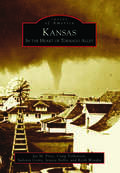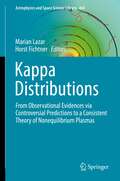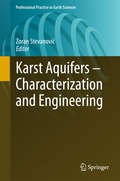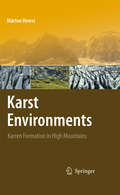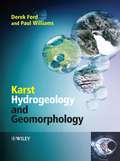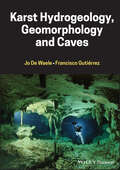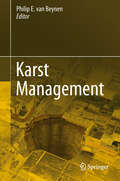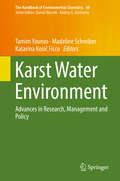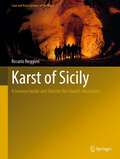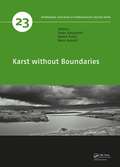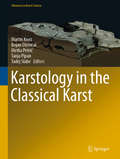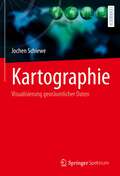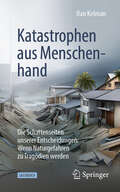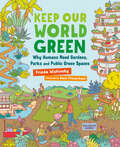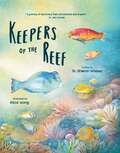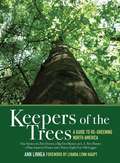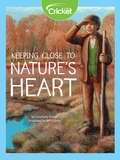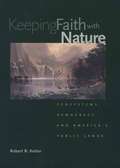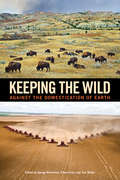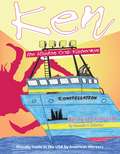- Table View
- List View
Kansas: In the Heart of Tornado Alley
by Jessica Nellis Craig Torbenson Jay M. Price Sadonia CornsBack in 1915, Snowden D. Flora of the US Weather Bureau wrote, "Kansas has been so commonly considered the tornado state of the country that the term 'Kansas cyclone' has almost become a part of the English language." Flora's words still seem to ring true. Whether called a twister, a tornado, a vortex, or cyclone, these catastrophic events have shaped lives in the Sunflower State for generations. Just a few destructive moments forever changed places such as Irving, Udall, Topeka, Andover, and Greensburg. Even before Dorothy Gale in The Wizard of Oz helped equate the tornado with Kansas, the turbulent nature of local weather seemed to parallel an equally turbulent history, with the fury of people such as John Brown compared to a cyclone. Even if they have never seen a funnel cloud themselves, those who live in Kansas have come to accept the twister as a regular and always unpredictable neighbor.
Kapital im Bergbau: Methoden, Best-Practice-Beispiele und Fallstudien zur Finanzierung von Bergbauprojekten
by Michael SeegerDer Bergbau ist eine kapitalintensive Branche mit langen Vorlaufzeiten für die Entwicklung von Projekten, die einen strukturierten Ansatz von der Minenexploration bis zur Stilllegung erfordern. Dieses Buch bietet Minenentwicklern, Investoren, Eigentümern, Aktionären und politischen Entscheidungsträgern einen umfassenden Plan zur Kapitalbeschaffung für die Entwicklung neuer Bergbauprojekte oder zur Unterstützung laufender Minen.Der Autor, ein erfahrener Berater für Bergbaukapital, zeigt, wie Minenentwickler und Minenbesitzer in jeder Phase des Rohstoffpreiszyklus, an jedem Standort und in jeder Projektphase Kapital beschaffen können. Das Buch folgt einem bewährten und strukturierten Ansatz, der es Minenentwicklern und -besitzern ermöglicht, erfolgreich Kapital für ihre Projekte zu beschaffen. Anhand von Fallstudien und praktischen Methoden lernt der Leser das Wesentliche zu Themen wie der Entwicklung und Vermarktung eines Business Case für Investitionen, den Arten und Quellen vonBergbaukapital für verschiedene Projektphasen sowie der Struktur und Bedeutung der Due Diligence. Der Autor stellt aktuelle Bergbauprojekte und deren Finanzierungspläne, Transaktionsstrukturen und Term Sheets für Kapital vor. Die besprochenen Bergbauprojekte repräsentieren verschiedene Projektstadien, Rohstoffe und Teile der Welt und bieten ein umfassendes Nachschlagewerk für Minenentwickler, Investoren und Projektträger gleichermaßen.
Kappa Distributions: From Observational Evidences via Controversial Predictions to a Consistent Theory of Nonequilibrium Plasmas (Astrophysics and Space Science Library #464)
by Marian Lazar Horst FichtnerThis book presents recent results on the modelling of space plasmas with Kappa distributions and their interpretation. Hot and dilute space plasmas most often do not reach thermal equilibrium, their dynamics being essentially conditioned by the kinetic effects of plasma particles, i.e., electrons, protons, and heavier ions. Deviations from thermal equilibrium shown by these plasma particles are often described by Kappa distributions. Although well-known, these distributions are still controversial in achieving a statistical characterization and a physical interpretation of non-equilibrium plasmas.The results of the Kappa modelling presented here mark a significant progress with respect to all these aspects and open perspectives to understanding the high-resolution data collected by the new generation of telescopes and spacecraft missions.The book is directed to the large community of plasma astrophysics, including graduate students and specialists from associated disciplines, given the palette of the proposed topics reaching from applications to the solar atmosphere and the solar wind, via linear and quasilinear modelling of multi-species plasmas and waves within, to the fundamental physics of nonequilibrium plasmas.
Karst Aquifers—Characterization and Engineering
by Zoran StevanovićThis practical training guidebook makes an important contribution to karst hydrogeology. It presents supporting material for academic courses worldwide that include this and similar topics. It is an excellent sourcebook for students and other attendees of the International Karst School: Characterization and Engineering of Karst Aquifers, which opened in Trebinje, Bosnia & Herzegovina in 2014 and which will be organized every year in early summer. As opposed to more theoretical works, this is a catalog of possible engineering interventions in karst and their implications. Although the majority of readers will be professionals with geology/hydrogeology backgrounds, the language is not purely technical making it accessible to a wider audience. This means that the methodology, case studies and experiences presented will also benefit water managers working in karst environments.
Karst Environments
by Márton VeressWith a focus on karren formation in high mountains, and specifically in the European Alps, this text summarizes the scientific results of systematic observations made during field trips, as well as the interpretation, using modern analytical methods, of the data collected. Márton Veress, who has been working in different types of karren landscapes for more than fifteen years, presents the conditions and processes of high mountain karren formation as well as the properties of karren features. The book analyzes karren phenomena, their development, and their formation under different environmental conditions. Introductory chapters provide an overview of karren formations, in addition to charting the history of research into karst environments at high altitude. The author then provides details of the sampling sites and the localities he has studied, and experimental procedures undertaken. After covering the details of the age and rate of karren form development, Veress gives an in-depth explanation of the general characteristics of high mountain karren formations. The text then provides an overview of morphogenetic types of karren formations as well as karren assemblages, and an explanation of karren belts on slopes, emphasizing the key reconstruction role they play in slope development. The final chapters describe coalescing types and their origin, offer the reader a detailed description of karren cells and their characteristic features, and analyze the relationship between different karren formations.
Karst Hydrogeology and Geomorphology
by Paul D. Williams Derek FordOriginally published in 1989, Karst Geomorphology and Hydrology became the leading textbook on karst studies. This new textbook has been substantially revised and updated.The first half of the book is a systematic presentation of the dissolution kinetics, chemical equilibria and physical flow laws relating to karst environments. It includes details of the many environmental factors that complicate their chemical evolution, with a critique of measurement of karst erosion rates. The second half of the book looks at the classification system for cave systems and the influence of climate and climatic change on karst development. The book ends with chapters on karst water resource management and a look at the important issues of environmental management, including environmental impact assessment, environmental rehabilitation, tourism impacts and conservation values. Practical application of karst studies are explained throughout the text."This new edition strengthens the book's position as the essential reference in the field. Karst geoscientists will not dare to stray beyond arm's reach of this volume. It is certain to remain the professional standard for many decades." Journal of Cave and Karst Studies, August 2007
Karst Hydrogeology, Geomorphology and Caves
by Francisco Gutierrez Jo De WaeleKarst Hydrogeology, Geomorphology and Caves A Comprehensive Resource Covering All Aspects of Karst Hydrogeology, Geomorphology, and Caves This essential book covers all physical, chemical, and geological aspects of karst science. It reviews current knowledge on hydrogeology, geomorphology and caves in karst, based on the vast existing literature and investigations carried out by the authors worldwide. The different topics are profusely illustrated with color figures and images from all continents and climates, showing the scientific and aesthetic appeal of karst environments. The book covers in a systematic way the significant features of karst rocks, the chemistry and kinetics of their dissolution, the rate and distribution of karst denudation, the unique hydrogeology of karst terrains, the landforms endemic to karst, the morphology of caves and their diverse sedimentary records, and the multiple processes that lead to the formation of underground voids. Overall, the work reflects the increasing recognition of karst as a fundamental part of the Earth’s dynamic systems, and helps readers understand this multidisciplinary field from a holistic and nuts-and-bolts perspective. Some of the ideas discussed within the book include: How karst is gaining importance for human development, because of its valuable resources (groundwater) and associated environmental problems (impacts and hazards) The enormous technological developments achieved in recent years Recent major breakthroughs in the field and their influence on other scientific disciplines The central role played by karst science for understanding and mitigating global environmental issues (global warming, depletion of resources, human-induced hazards) For all scientists working in karst, and for students and lecturers of karst-related programs, this book serves as a valuable all-in-one source. It is also a valuable resource for professional hydrogeologists, the petroleum industry, environmental geologists, and of course speleologists, the last true geographic explorers in the world.
Karst Management
by Philip E. BeynenFocusing specifically on the management of karst environments, this volume draws together the world's leading karst experts to provide a vital source for the study and management of this unique physical setting. Although karst landscapes cover 12% of the Earth's terrain and provide 25% of the world's drinking water, the resource management of karst environments has only previously received indirect attention. Through a comprehensive approach, Karst Management focuses on engineering issues associated with surface karst such as quarries, dams, and agriculture, subsurface topics such as the management of groundwater, show caves, cave biota, and geo-archaeology projects. Chapters that focus on karst as an integrated system look at IUCN World Heritage sites, national parks, policy and regulation, measuring systematic disturbance, information management, and public environmental education. The text incorporates the most up-to-date research from leading karst scientists. This volume provides important perspectives for university students, educators, geoengineers, resource managers, and planners who are interested in or work with this unique physical landscape.
Karst Water Environment: Advances In Research, Management And Policy (The Handbook of Environmental Chemistry #68)
by Tamim Younos Madeline Schreiber Katarina Kosič FiccoKarst aquifers are important sources of drinking water worldwide. This volume presents a discussion of the current state of knowledge on karst science, advances in karst mapping and karst aquifer monitoring technologies, case studies of karst aquifer assessment, and regulatory perspectives on land use and water management in karst environments. It offers valuable reference material for researchers involved in karst science and environmental studies, as well as a guide for experts at governmental agencies, scientists, engineers and other professionals involved in karst aquifer protection and the design of land and water management systems in karst areas around the globe.
Karst of East Herzegovina and Dubrovnik Littoral (Cave and Karst Systems of the World)
by Petar MilanovićThe area of Eastern Herzegovina is one of the most karstified regions in the world. Deep karst, sinking rivers, underground flows, temporary flooded karst poljes and lack of arable land is main natural property of the region. Due to two kinds of misfortune, flood and drought, people have emigrated from this region searching for a better life. The book contains new scientific data and engineering experience collected during more than 100 years of investigations and construction. To provide optimum water management and economic development, thousands of new data are collected and presented in the book. Necessity for balance between regional development and preservation of nature was one of the important request.
Karst of Sicily: A Journey Inside and Outside the Island’s Mountains (Cave and Karst Systems of the World)
by Rosario RuggieriThis book describes Sicily’s unique and varied karst features, discussing the notable geographical areas, their lithology and genesis and, in a number of cases, their value as geosites to be preserved for scientific or tourism purposes. The rich variety of Meso-Cenozoic outcropping rocks in Sicily make the island highly significant in terms of the geological history of the Mediterranean area.The soluble rocks (limestones and gypsum), widely present on the island, play an important role in shaping and continuously altering the landscape, both in the reliefs with spectacular fluviokarst cayons and suggestive gorges, and below ground where there is a wide range of speleogenically and speleologically important caves.
Karst without Boundaries (IAH - Selected Papers on Hydrogeology)
by Zoran Stevanović Neven KrešićKarstified rocks of different lithology cover more than 10% of the continental surface of our planet. It is known that some 20% or even a few percent more of the global population largely depends on karstic groundwater but in many karst areas all over the world there are limited natural resources including absence of drinking waters. The problems o
Karstology in the Classical Karst (Advances in Karst Science)
by Hong Liu Martin Knez Metka Petrič Tadej Slabe Stanka Šebela David C. Culver Bojan Otoničar Tanja Pipan Matej Blatnik Franci Gabrovšek Blaž Kogovšek Janja Kogovšek Cyril Mayaud Andrej Mihevc Janez Mulec Magdalena Năpăruş-Aljančič Mitja Prelovšek Nataša Ravbar Trevor Shaw Nadja Zupan HajnaThis book presents the latest advances in karstology by researchers at the ZRC SAZU Karst Research Institute, Slovenia – home of Classical Karst. It features interdisciplinary investigations carried out on the karst surface, subsurface, caves, and associated waters.It covers various topics, such as analysis of karst processes, including the mineralogical and lithological characteristics of sediments and carbonate rocks; structural geological mapping; detecting the old traces of paleokarst; the formation of karst surfaces in a variety of types of rock and conditions; and the evolution of karst, which can aid in dating sediments, and in tracing aquifers using artificial and natural tracers. In addition, the book provides detailed information on the use and development of various research methods, ranging from comprehensive field research, long-term measurements, and laboratory analyses to computer and laboratory modeling. Integrating karst geology, geomorphology, hydrology, ecology, speleobiology, and microbiology research, these methods provide readers with a far deeper understanding of karst terrains.
Kartographie: Visualisierung georäumlicher Daten
by Jochen SchieweWie würde unser Leben aussehen, wenn es keine (guten) Karten gäbe?Karten helfen dem Menschen, sich besser und schneller zu orientieren, zu navigieren sowie die komplexe Umwelt auf das Wesentliche zu reduzieren und schließlich besser zu verstehen. Die Visualisierung von georäumlichen Daten unterstützt Laien und Experten bei ihren alltäglichen Aufgaben im privaten, beruflichen oder wissenschaftlichen Bereich. Es werden immer mehr Karten erstellt, dank des Internets immer schneller verbreitet und auf unterschiedlichen Endgeräten wie Smartphones oder Tablets auch im Alltag genutzt. Der Trend zu immer mehr Karten bedeutet allerdings nicht, dass auch immer mehr „gute“ Karten erstellt werden – also solchen Karten, die ihren Zweck tatsächlich effizient erfüllen.Das Buch deckt die ganze spannende Breite des Faches Kartographie ab: Zum einen wird der Kern der Disziplin behandelt, der sich mit der graphischen Kodierung von georäumlichen Objekten und Eigenschaften sowie dem Raumbezug bzw. den Kartenabbildungen beschäftigt. Zum anderen werden wichtige Randbereiche für das „Rundum-Verständnis“ behandelt – z. B. die Überprüfung der Gebrauchstauglichkeit von Karten, die Erfassung und Verarbeitung der zugrundeliegenden Geodaten oder das Kartenrecht. Statt technischer oder Software-abhängiger Beschreibungen legt der Autor den Fokus auf die Vermittlung von Konzepten und Methoden der modernen Kartographie. Hierzu tragen einführende Überblicke zu den Kapiteln, zahlreiche Abbildungen sowie viele Übungsaufgaben bei.Ein wichtiges Lehrbuch, das Studierenden und Lehrenden aus vielen Disziplinen (Kartographie, Geographie oder Geodäsie, Stadt- und Regionalplanung oder Umweltwissenschaften u. v. a.) bei der Gestaltung und Nutzung solcher „guter Karten“ hilft. Auch andere, einfach „nur“ kartenbegeisterte Menschen werden von den hier beschriebenen Grundlagen der modernen Kartographie profitieren.
Katastrophen aus Menschenhand: Die Schattenseiten unserer Entscheidungen: Wenn Naturgefahren zu Tragödien werden
by Ilan KelmanEin Erdbeben erschüttert Haiti und ein Hurrikan wütet in Texas. Wir hören, dass die Natur wütet und versucht, uns durch diese "Naturkatastrophen" zu zerstören. Die Wissenschaft erzählt eine andere Geschichte: die unbequeme Wahrheit, dass Katastrophen nicht die Folge von natürlichen Ursachen sind, sondern die meisten "Naturkatastrophen" durch menschliche Entscheidungen verursacht werden.In diesem Buch erfahren Sie, wie Katastrophen vermieden werden können und sollten. Menschen mit politischer Macht, Geld und Möglichkeiten, allen zu helfen, vermeiden aktiv, Katastrophen zu verhindern, wenn die Natur ihre Kräfte und Energien entfesselt. Sie werden von Beispielen für schreckliche Katastrophen wie Erdbeben und Hurrikane in Haiti lesen, neben inspirierenden Erfolgen im Umgang mit Waldbränden in Colorado und Überschwemmungen in Toronto und Bangladesch. Die Geschichten nehmen Sie mit auf eine Reise um die Welt und in die Vergangenheit, um die komplexen Faktoren zu erkunden, die Katastrophen verursachen. Die Politik diktiert, wo und was wir bauen, während sie Armut, Marginalisierung und Diskriminierung schafft und aufrechterhält. Wir sollten die Menschen, die diese Entscheidungen treffen, für Katastrophen verantwortlich machen. Doch stattdessen konzentrieren wir uns auf Umweltfaktoren oder Gottheiten, die Todesfälle, Schäden und Störungen "verursachen".Die Politik diktiert, wo und was wir bauen, während sie Armut, Marginalisierung und Diskriminierung schafft und aufrechterhält und wir konzentrieren uns auf Umweltfaktoren oder Gottheiten, die Todesfälle oder Schäden "verursachen". Dieses Buch handelt von der Unfähigkeit der Menschheit, mit der Umwelt und mit uns selbst, kollektiv und individuell, umzugehen. Es wird Sie dabei unterstützen, bessere Entscheidungen zu treffen, um zukünftig dazu beizutragen Katastrophen zu verhindern.
Kate Shelley and the Midnight Express
by Margaret K. WettererIntroduce young readers to history through the stories of both real and fictionalized people. By focusing on a single important episode that describes a historical event, these books engage readers' interests and imaginations. Written in a story format, each account relates events that really happened, often followed by a brief summary of the historical event to further explain the significance it had on history.
Keep Our World Green: Why Humans Need Gardens, Parks and Public Green Spaces (Orca Timeline)
by Frieda WishinskyGreen space is good for us all. Parks and gardens bring life to communities big and small all over the world and provide a habitat for native plants and animals. Ensuring access to these outdoor spaces can inspire art, music and literature and create ways for communities to grow their own food. But today, green space everywhere is at risk. Keep Our World Green looks at how green space has evolved throughout history, from the first public garden to the origins of bonsai trees. It examines the political, social and environmental challenges of maintaining green spaces because of pollution, inequality and the effects of the climate crisis. It also introduces the people working to protect these places for the future—you can be a green space activist too! Come on, let’s take a walk in the park together! The epub edition of this title is fully accessible.
Keeper Of The Swamp
by Ann GarrettAboy and his ailing grandfather pole a small boat out into the Louisiana bayou. Suddenly, they spot Boots, a female alligator the grandfather saved from poachers years ago. <P><P>How will the boy face the danger in learning to take care of this wild creature? Strikingly illustrated with artwork that combines oil painting and computer imaging, Keeper of the Swamp is a scary and satisfying tale that carries a strong environmental message.
Keepers of the Reef
by Sharon WismerTakes children to the underwater world of Australia's Great Barrier Reef for a prime example of how a complex ecosystem depends on its keystone species. Sharon Wismer—reef ecologist and mom—is the best tour guide a kid could have for a visit to the underwater world of Australia’s Great Barrier Reef. Alice Wong’s richly detailed, accurate watercolors take a boy and girl snorkeling to see the fishes that maintain the ecological balance between the corals and their main competitor, algae. Without the fish species that brush, crop, scrape, excavate, and browse the algae, coral reefs would die. A coral reef is a brilliant and colorful example of how a complex ecosystem functions and why its keystone species are critical to its health. The Great Barrier Reef is one of Earth’s most celebrated natural treasures. Here children discover why the reef is threatened and what we can all do to help protect it. Endorsements are coming from Charlie Veron (“the godfather of coral,” featured in the 2017 film Chasing Coral) and David Bellwood, a world-renowned reef fish ecologist whose lab is the source of much of the information in this book. Keepers of Reef is the rare children’s book combining cutting-edge science with narrative and pictorial magic. Thorough backmatter sources and resources are included.
Keepers of the Trees: A Guide to Re-Greening North America: True Stories of a Tree Doctor, a Big Tree Hunter, an L.A. Tree Planter, a Plant Amnesty Pruner, and a Ninety-Eight-Year-Old Logger
by Lyanda Lynn Haupt Ann LinneaEngage in the life stories of fourteen people whose lives have been shaped by trees-featuring the true stories of a tree doctor, big tree hunter Will Blozan, Plant Amnesty's pruner, and ninety-four-year-old logger Merve Wilkinson. Also interviewed is Vietnam veteran Bud Pearson, whose post-traumatic stress disorder found healing and acceptance as a wood carver in the wilds of Montana, as well as Andy Lipkis, founder of TreePeople, who has spent thirty-five years ripping up concrete in L.A. to plant over two million trees in an effort to stop flooding and reduce air pollution. Each tree keeper reveals the inspiration and organization behind their advocacy with detailed explanations and touching stories of how their lives have come to be shaped by the forests they are fighting to preserve. Keepers of the Trees includes stories from all over North America, including Vancouver, Chicago, L.A., and Montana. This book includes one hundred color photographs of the tree keepers in action as well as diagrams illustrating the keepers' work. These are inspirational stories of conservation, healing, passion, and advocacy for any classroom, conservationist, activist, and nature lover.
Keeping Close to Nature's Heart
by Carollyne HutterEvery visitor of Yosemite National Park in California should say "thank you" to one man: John Muir.
Keeping Faith with Nature: Ecosystems, Democracy, and America's Public Lands
by Robert B. KeiterAs the twenty-first century dawns, public land policy is entering a new era. This timely book examines the historical, scientific, political, legal, and institutional developments that are changing management priorities and policies--developments that compel us to view the public lands as an integrated ecological entity and a key biodiversity stronghold. Once the background is set, each chapter opens with a specific natural resource controversy, ranging from the Pacific Northwest's spotted owl imbroglio to the struggle over southern Utah's Colorado Plateau country. Robert Keiter uses these case histories to analyze the ideas, forces, and institutions that are both fomenting and retarding change. Although Congress has the final say in how the public domain is managed, the public land agencies, federal courts, and western communities are each playing important roles in the transformation to an ecological management regime. At the same time, a newly emergent and home-grown collaborative process movement has given the public land constituencies a greater role in administering these lands. Arguing that we must integrate the new imperatives of ecosystem science with our devolutionary political tendencies, Keiter outlines a coherent new approach to natural resources policy.
Keeping the Air Clean
by John BainesKEEPING THE AIR CLEAN. If we don't stop pumping greenhouse gases into the air, by 2100 the earth may be 7 degrees F (4 degrees C) warmer. Without air there would be no life on our planet, yet we are now poisoning the air we breathe. It isn't too late; if we act now, there is still time to repair the damage we have done. The world's seven richest countries are responsible for one third of global warming. In Norway 92 percent of the air pollution that causes acid rain is blown in from other countries. If we stop producing CFCs now, the ozone layer could recover by 2050.
Keeping the Wild: Against the Domestication of Earth
by Tom Butler George Wuerthner Eileen CristIs it time to embrace the so-called "Anthropocene"--the age of human dominion--and to abandon tried-and-true conservation tools such as parks and wilderness areas? Is the future of Earth to be fully domesticated, an engineered global garden managed by technocrats to serve humanity? The schism between advocates of rewilding and those who accept and even celebrate a "post-wild" world is arguably the hottest intellectual battle in contemporary conservation. In Keeping the Wild, a group of prominent scientists, writers, and conservation activists responds to the Anthropocene-boosters who claim that wild nature is no more (or in any case not much worth caring about), that human-caused extinction is acceptable, and that "novel ecosystems" are an adequate replacement for natural landscapes. With rhetorical fists swinging, the book's contributors argue that these "new environmentalists" embody the hubris of the managerial mindset and offer a conservation strategy that will fail to protect life in all its buzzing, blossoming diversity. With essays from Eileen Crist, David Ehrenfeld, Dave Foreman, Lisi Krall, Harvey Locke, Curt Meine, Kathleen Dean Moore, Michael Soulé, Terry Tempest Williams and other leading thinkers, Keeping the Wild provides an introduction to this important debate, a critique of the Anthropocene boosters' attack on traditional conservation, and unapologetic advocacy for wild nature.
Ken the Alaskan Crab Fisherman: Bering Sea King Crab
by Ken BottcherI am truly blessed to be living in the most beautiful place on God's green earth, Valdez, Alaska. Valdez is located in Prince William Sound on Alaska's Gulf coast and is surrounded by natural beauty unequaled, in my opinion, anywhere else on earth. Though my commercial fishing days are far behind me in life, I truly enjoy writing stories I hope inspire children to work hard and follow their dreams.
